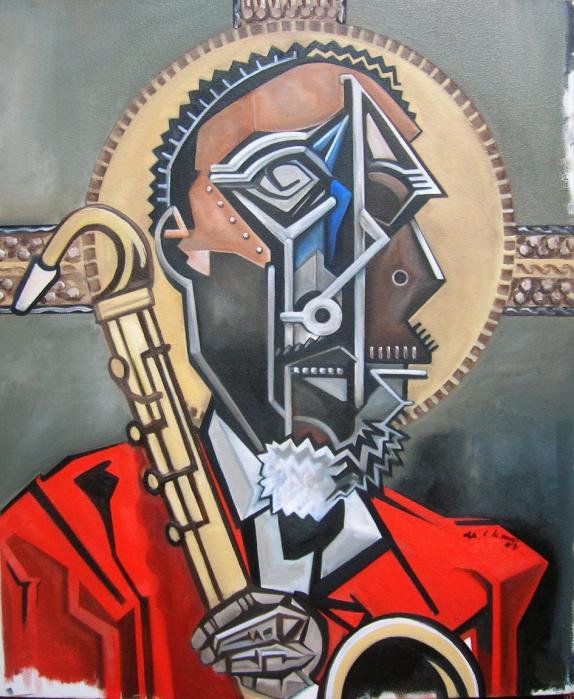1959 was a watershed year for jazz music (arguably the greatest single year for jazz in all history–which is saying a lot). Here’s a taste: Miles Davis Kind of Blue, John Coltrane Giant Steps, Charles Mingus Ah Um. That is like the holy trinity of jazz music; all from the same year. But in the not-so-silent shadows a young, relatively unknown alto saxophonist was poised to cause a stir that still reverberates today: Ornette Coleman’s provocatively titled The Shape of Jazz to Come.
Kind of Blue is correctly celebrated for establishing modal music, and a genuine evolution from bop and post-bop; Giant Steps is the apotheosis of the “sheets of sound” that John Coltrane had been practicing and perfecting for a decade; Ah Um is an encyclopedic history of jazz music, covering everyone and everything from Jelly Roll Morton to Duke Ellington. And each of those albums were immediately embraced, and remain recognized as genuine milestones today. But The Shape of Jazz to Come was incendiary and complicated: it inspired as much resistance as it did inspiration. Some folks (Mingus included) bristled that it was all so much sound and fury, signifying…little. But what Coleman (along with trumpet player Don Cherry, bassist Charlie Haden and drummer Billy Higgins — representing as solid a quartet as any that have made music, ever) achieved was, arguably, the most significant advancement since Charlie Parker hit the scene.
Of course, Parker was also misunderstood and dismissed when his frenetic, almost incomprehensibly advanced alto saxophone assault began to cause scales to drop from audiences’ eyes — if not their ears. Like any genuine iconoclasts of the avant garde, Parker and Coleman were not being new for newness sake; they had to fully grasp and master the idiom before they could transcend it. Tellingly, what was revolutionary and almost confrontational, then, seems rather tame and entirely sensible, now. Of course, it didn’t take 50 years for Coleman to resonate: he not only found his audience, John Coltrane –the all-time heavyweight champion– embraced his compatriot. He endorsed, and, crucially, he imitated. The Book of Revelation that Coltrane’s mid-’60s Impulse recordings comprise did, in many respects, grow directly out of the opening salvo fired by Coleman in ’59.
Flash forward ten years. Miles Davis was once again at the vanguard, nonchalantly picking up the baton dropped when free-jazz avatars Eric Dolphy and John Coltrane had their comet-like lives come crashing, way prematurely, to earth. By ’69, Miles had “plugged in”, augmented his quintet and went about the inconsequential task of changing music (again). To say that his endeavors were met with similar resistance as those of Coleman a decade before is putting it mildly. Indeed, while Ornette was eventually recognized, even lionized (witness his most-deserved 2007 Pulitzer for the masterful Sound Grammar ), the work Miles did in the late ’60s and early ’70s was met with a combination of incredulity, indifference and outright hostility (it also was warmly embraced by people with the ears to hear it). Much more on this era and the culmination of his experimentations which resulted in Bitches Brew, very shortly (stay tuned).
Suffice it to say, Miles led the charge that led to, depending upon one’s point of view, a radical expansion of jazz music’s possibilities or its lamentable bastardization. Certainly the (inevitable, unfortunate) proliferation of watered down fusion which resulted in the artistic stillbirth known as Smooth Jazz has little (if anything) to do with the shock heard ’round the world that Miles sounded off circa 1970.
What happened next is, again depending on one’s perspective, the languid death march of America’s music or a continuation of an art that seamlessly integrates virtually every noise and culture from around the globe. A certain, and predictable, cadre of critics submerged their heads in the sand and bitched about better days. The awake and aware folks who make and receive these offerings celebrate an ever-evolving music that resists boundaries and is capable of communication transcending language and explanation. At its best it is an ideal synergy of expression and integrity.
Anyone who knows anything understands that some of the best jazz music ever was created in the ’70s (no, really) and a great deal of amazing music was made in the ’80s (seriously). But in the ’90s and into the ’00s we’ve seen jazz music consistently –and successfully– embrace other forms of music (rock, rap, electronica, etc.) and end up somewhere that remains jazz, yet something else altogether. There are myriad examples, of course, but this small sampler of five selections might be illustrative, and enlightening. The uninitiated may be surprised, even astonished, at how alive and accessible this “other” music really is.
One could (and should) say more about artists such as Lester Bowie, Jamie Saft, Marco Benevento, The Bad Plus, Critters Buggin, Garage a Trois and Mostly Other People Do The Killing, all of whom have incorporated our (increasingly) info-overload existence into their sound. Slack-jawed and stale-souled haters may demur at even calling this Jazz, or course. And of course the last laugh is on them because most of these musicians would care less than a little what you call it. They understand that the shape of jazz that came is always turning into what we’ll be listening to tomorrow.
1. DJ Spooky (with William Parker, Joe McPhee and Guillermo E. Brown), “ibid, desmarches, ibid” (from Optometry):
2. Material, “Black Light” (from Hallucination Engine):
3. Matthew Shipp, “Cohesion” (from Equilibrium):
4. John Zorn, “Giù La Testa (Duck You Sucker!)” (from The Big Gundown):
5. Medeski, Martin and Wood (with DJ Logic), “Start-Stop” (from Combustication):


